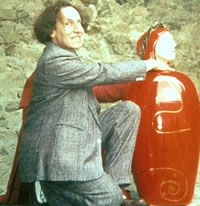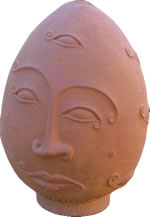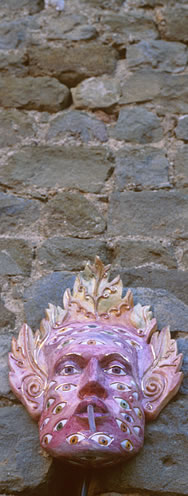 |
 The
egg of Pin-occhio* The
egg of Pin-occhio*
"In the beginning of the Universe / the goddess was alone. / She
laid the Egg of the world". This is the image of the bird-goddess
as presented by the Indian mythology (1). According to certain myths,
the bird which lays the egg is the same one which sits on it; it is the
spirit that fecundates the formless matter (as for example the Holy Spirit,
represented in the Bible as a white dove). In all the different symbologies,
the idea of the Universal Chaos is closely related to the Cosmic Egg.
But the egg is in itself already a first stage in the organization of
the chaos: in all cultures, it is the principle and the symbol of Unity.
The egg is therefore androgynous: in some African cultures, the yellow
of the yolk represents the "humid" female principle, whereas
the white of the albumen stands for the male semen. "Outside, the
gods’ white rock has been created upon the egg’s shell. Inside,
a lake (as white as mother-of-pearl) clearly whirled in the liquid part
of the egg" (taken from the Po ti bse ru, a Tibetan work). In this
same way, Leda’s egg is also androgynous: Castor is associated to
Clytemnestra (and thus to the sons of Tyndareus, that is, the mortal side)
and Pollux to Helen (and thus to the sons of Zeus-swan, that is, the divine
side, with which Dali identified himself with regard to Gala). Besides
its obvious significance as birth and origin of life as well as of the
world, the egg is also a symbol of death, that is, of the eternal Life.
The egg is "paschal" because its meaning includes death, too
(the egg that gets broken represents the sepulchre that opens to allow
resurrection). Mircea Eliade wrote: "The egg as a symbol is not as
much related to a birth as to a rebirth, which occurs again and again
according to the cosmogonic model... The egg confirms and promises resurrection
which is ... not a birth, but rather a return, a repetition." Easter
comes in Spring, at a time when nature rises again from the winter sepulchre.
The egg is an esoteric symbol, too, it is the vase in which the alchemical
transmutations take place. An alchemistical interpretation of the tale
"Pinocchio" is also possible, especially of one particular chapter of it: that namely
in which the hungry puppet tries to make a fried egg, but without using
any oil or butter (elements of the anointing which is preparatory to the
operation), and using water instead (the "bain-marie"). It is
then that a chick comes out of the egg (according to the explanation of
the "cooking", the chick is the Infant Jesus, the philosophers’
stone, Gold). Eggs and chicken also fill Pappi Corsicato’s movie
Buchi neri ("Black holes"). In it, a resurrection is announced
(the name of one of the lead characters is namely Angela), while the different
figures continue walking on a dismal street of Naples’ suburbs (reminding
of Bunuel’s movie The charme discret de la bourgeoisie): when they
are miraculously reborn, a huge egg appears above the hill.
is also possible, especially of one particular chapter of it: that namely
in which the hungry puppet tries to make a fried egg, but without using
any oil or butter (elements of the anointing which is preparatory to the
operation), and using water instead (the "bain-marie"). It is
then that a chick comes out of the egg (according to the explanation of
the "cooking", the chick is the Infant Jesus, the philosophers’
stone, Gold). Eggs and chicken also fill Pappi Corsicato’s movie
Buchi neri ("Black holes"). In it, a resurrection is announced
(the name of one of the lead characters is namely Angela), while the different
figures continue walking on a dismal street of Naples’ suburbs (reminding
of Bunuel’s movie The charme discret de la bourgeoisie): when they
are miraculously reborn, a huge egg appears above the hill.
Luigi Ontani was born, so to speak, in the shade of an egg. "In a
scenery reminding of the Arabian Nights there is Montovolo, the egg-shaped
mountain which acts as the prolific forefather both of the castle and
of the artist." (2). The castle is La Rocchetta in Riola di Vergato
(and Vergato is the village in the Subappennines where Ontani was born),
which was built in a faked oriental, Moorish style by order of the Count
Mattei, an alchimist and one of the first homeopathists. Precisely within
the walls of the "Fortezza dell’arte" in Montalcino, Ontani
displays six large terra-cotta eggs. The material used indicates in itself
the deep bonds which tie Ontani to the energy of the earth. The eggs will
probably be scattered around, as if born out of a spontaneous sprouting:
on the retaining wall, among the vases, imprisoned in the in-between space
of the balcony, camouflaged so that each of them will be a surprise (eggs
usually contain surprises: for example, children’s plays are inside
chocolate eggs in use for Easter, and a chick is found in the egg of Pinocchio
- a character Ontani has dealt with for a long time). Eyes are wide open
on these closed egg-shapes and form a spiral reaching as far as the pineal
eye, which is smiling and melancholic at the same time. Pineal is the
name given to a "small gland in the brain; it is cone-shaped and
it takes the form of a reddish limp pine-cone situated behind the thalamuses;
in ancient times it was considered as the seat of the soul; its function
is little known (slowing effect on the growth of the body)" (definition
taken from the "Zingarelli" dictionary). So, does perhaps an
(almost) useless gland, an unknown mysterious organ, reduce the speed
of the body’s growth in order to increase that of the soul, which
it was thought was dwelling there? The theme of the egg was already present
in Ontani’s works, where it was always coupled witht hat of the eye:
Uomo, uovo, occhio ("Man, egg, eye") or Pinealissima [This part
of the title is impossible to translate, as it refers to the pineal gland,
the word being the superlative degree of the adjectiv "pineal"
- Note of the Translator] are the titles of a mask created in 1982 which
was covered with eyes; a like image can be found in his 1993 self-portrait,
a photograph touched up with water colors, bearing the title Uomo che
guarda l’ontano or Pinealana [the first part of the title plays with
the words "l’ontano", hinting at the author’s name
Ontani and "lontano", that is, "far away", while the
second part is again a reference to the pineal gland - Note of the Translator].
Avo Ovo Pavoneale is the title given to another image combining the egg
with the eye and referring to the peacock, the animal upon which Hera
transferred the one-hundred eyes of Argos when the latter was killed (his
eyes took turns in sleeping, fifty at a time). Covered up with eyes is
also the mask called EgGoista (the name plays on the English word for
the egg) (3). This is precisely the matrix of the works on the theme of
the egg, which in turn echoes the experience of his 1982 journey to Bali.
EgGoista is a huge mask which covers the whole of the body when squatting,
except the feet. A body-mask is also that in the form of an egg with a
nose like that of Pinocchio: there, the typical cone-shaped hut is obtained
from an alder’s twisted leaf made of leather with little mirrors
on top. The title of the work is Pinocchiovo/Pinovocchio (where the author
is again playing on the words "Pinocchio" and "ovo"="egg"
- Note of the Translator). The egg had also appeared in the last of the
"grilli" [=crickets] ("talking crickets", maybe?****):
the Grillo Mediolanum, where the egg is that of Fontana, but also that
of Piero della Francesca. Thus, the egg is the symbol of a synthesis and
at the same time of unity and of the birth of the city, and it can be
understood by everybody notwithstanding their cultural references.
The funerary aspect of the egg is also expressed in the Canopo ("canopic
vase") made in poychromed fired clay: it draws inspiration from the
ancient funeral vases made in terra-cotta or bronze which had a cover
in form of a human head and handles representing the arms. The canopic
vase was generally arranged on a peculiar support made of terra-cotta
or bronze, which had the shape of a throne with a base in form of a truncated-cone
and a back. It was the typical product of the Etruscan village of Chiusi
(not far from Montalcino) during the 7th and the 6th century B.C. Curious
is the fact that the "canopo" is an element which underwent
a transformation, i.e., a stylization, resembling that of the "grilli":
these were fantastic head-and-legs figures of ancient times which became
very popular during the Middle Ages; they have been used by Ontani since
the "tableau vivant" which was inspired by the Temptations of
St. Anthony by Bosch and which was exhibited in Amsterdam on the occasion
of the first one-man show of the artist abroad, in 1975. Besides the six
eggs and the "Canopo", there will also be a wineyard-like row
of eight masks which will pour water and wine. As usual, Ontani will draw
inspration from the site itself, and wine is probably the most typical
product of Montalcino. The masks could be used to decorate the high retaining
walls around the entrance yard following the passageway.There are two
series of masks, both referring to the seasons: the works of the first
one, made in watercolors, have the initial letters Prim., Aut., etc. ("spring",
"autumn",) as their titles, whereas the masks of the second
one, richer in colors, have their names modified according to puns: Primav/eros
[playing with the words "primavera" - that is, "spring"
- and "eros"; Note of the Translator], Esta/si [playing with
the words "estate" - that is, "summer" - and "si"
= "yes", to build the word "ecstasy"; Note of the
Translator], Inver/o [playing with the words "inverno" - that
is, "winter" - and "invero" - that is, "in truth",
"truly"; Note of the Translator]. There might be a participation
of the poet Valentino Zeichen who (together with Luciano Pistoi and Marco
Noire) had published the book Svanimento, promptly re-named by Ontani
Valentino sesso e vino ("Valentine sex and Wine"), echoing the
famous Marcellino pane e vino. It is also possible that the exhibition
will be accompanied by a treble voices’ choir performing songs centering
on wine and providing a suitable sound track for the complex and yet agile
installation, which will be filled only by extremely light echoes and
harmonies. This mystical mixture of poetry, music and wine creates a Dionisyac
ambience which reminds of BacCasco, the exhibition organized by Pistoi
in Volpaia, in 1993. Ontani celebrated there the Eucharistic Mystery of
the Last Supper, contaminating it with pagan images like that of Bacchus
(the artist had already dedicated a tableau vivant to Caravaggio’s
Bacchino malato). "On a small window of the apse there is even a
S. Eufresino pan e vino. The title is ambiguous, though, for in it "pan"
has a double meaning: it can in fact be related both to the bread which
is the symbol of the said Supper and to another God, namely Pan, comingt
straight from the innumerable gods of the past. Once more we must recognize
that "poverty" does not suit Ontani, who prefers to resort to
his peculiar redundancy in order to avoid any kind of hinting at a Franciscan
pauperism." (4). On that occasion, Ontani’s mystical creations
were surrounded by the verses of young poets. While the artist looks lovingly
at his works**, the philosophical question, whether the egg came first,
or the chicken, can be considered as solved: "The Egg of the world
and the Bird which lays it are contemporaries" (5). It is the egg
of Pin-occhio, but also that of Columbus***, the latter being a figure
whith whom Ontani identified at the time of his arrival in America as
well as at that of the arrival of the American art in Italy.
Notes
1) Bahvricha Upanishad, in C Amariu, L’Uovo, published by Edizioni
Mediterranee, Roma, 1988, page 24.
2) A. Borgogelli, Viaggio di un paggio saggio in Bac/Casco, catalogue
of the exhibition held at the Castello di Volpaia, 1993, page 2
3) The theme of the eyes as expressed by Ontani is dealt with by M. Brusatin
(Oculocromia o del colore degli occhi) and by G. P. Bona (Lo scolaro di
Proteo) in the publication Idea Aida del Vero Diffida, a catalogue for
the exhibition organized by R. Barilli at the Galleria dello Scudo in
Verona, in 1995. With reference to titles as plays on words, compare G.
Belli, Ecce Puer and D. Eccher, Sogni l-ontani, both in Trentazioni, catalogue
for the exhibition at Studio Raffaelli in Trento, in 1994.
4) A. Borgogelli, op. cit., page 16.
5) A. Amariu, op. cit., page 95. Information about the symbology of the
egg, about the alchemical process and on the esoteric interpretation of
the tale "Pinocchio" are taken mainly from this book, as well
as from J. Chevalier, A. Gheerbrant Dictionnaire des symboles, Robert
Laffent/Juppiter, Paris 1982, and N. Coce e A. Zambrana, Pinocchio e i
simboli della grande opra, published by Atanor, Roma, 1984.
|
 |

